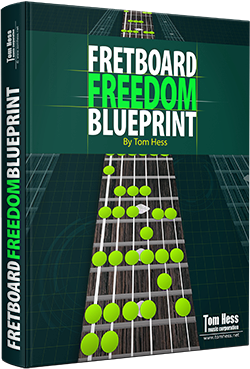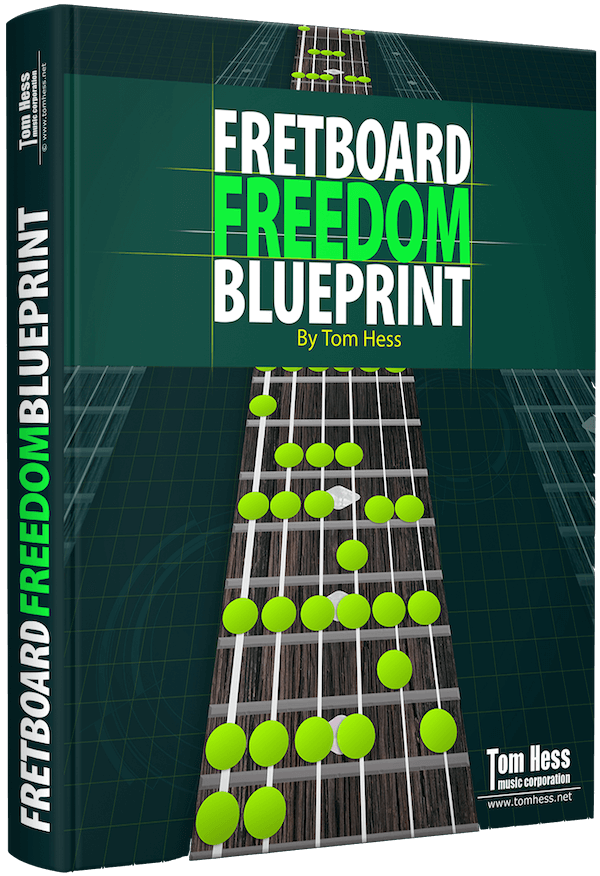The Best Way To Learn Notes On Guitar And Memorize The Guitar Fretboard

EMAIL TO GET ACCESS
By submitting your info, you agree to send it to Tom Hess Music Corporation who will process and use it according to their privacy policy.
If you’re serious about your lead guitar playing...
You probably know it’s essential to learn notes on guitar.
But if you’re like most guitarists...
You’re probably wasting WAY too much time trying to memorize the guitar fretboard the wrong way.
Here is what I mean:
If you’re trying to learn notes on guitar by focusing on letter names of the frets...
You’re memorizing a bunch of mostly useless information.
And you’re (unnecessarily) creating problems that will get in the way of your musical creativity.

EMAIL TO GET ACCESS
By submitting your info, you agree to send it to Tom Hess Music Corporation who will process and use it according to their privacy policy.
In this article...
I’ll show you a simpler and far more powerful way to memorize the fretboard that enhances your musical creativity.
Plus...
It gives you the ultimate musical freedom to play lead guitar the way you want.
To begin:
Watch this video on what it ‘really’ means to learn notes on guitar and memorize the fretboard:
Here are five more tips that will help you memorize the fretboard way faster (and use that knowledge to level-up your musical creativity).
Tip #1 For How To Memorize The Fretboard: Practice Playing Lead Guitar Licks Over Single Chord Backing Tracks
This is a fantastic way to not only learn notes on guitar, but also improve your musical creativity and lead guitar soloing skills.
As the name implies, you find (or create) a backing track that contains only one chord. Then, play a short (2-4 note) guitar lick over that chord. Repeat your lead guitar lick for a good 45-60 seconds.
And as you do, focus on:
- knowing what note in the scale you are playing.
- recalling the note’s function over the chord.
- remembering the sound of that function (and the feeling it creates).
- refining the phrasing of the notes.
Here is an example of this process:
Alternate between singing the notes and playing them (with the most expressive phrasing you can).
How does practicing this help to memorize the guitar fretboard and learn notes on guitar?
Simple:
 Create Tons Of Rock Guitar Licks
Create Tons Of Rock Guitar LicksEasily write an endless supply of
rock guitar licks with this video.
 Improve Your Lead Guitar Playing
Improve Your Lead Guitar PlayingLearn the key factor in becoming
a better lead guitar player fast.
 Get 10 Powerful Guitar Solo Tips
Get 10 Powerful Guitar Solo TipsUse these ten guitar soloing tips
to improve your guitar playing.
Instead of trying to learn notes on guitar in isolation (which does nothing to train your musical creativity as a lead guitarist)...
You are practicing memorizing the functions of the notes in a musical context.
This helps you to achieve the Holy Grail of musical skills (that levels up your musical creativity):
The ability to explain and predict the emotional impact of the notes you play on your listeners.
In addition, it forces you to make the lead guitar notes you’re playing sound expressive.
That’s because you cannot fall back on playing ‘lots of notes’ the way lead guitar players typically do. (And you’re forced instead to make those notes express genuine emotion.)
Likewise, you don’t have ‘other chords’ to add interest to what you’re playing. It all comes down to the phrasing of the notes.
After practicing one lick for a minute or so, switch to another lead guitar lick and repeat the process.
Do this for 10-15 minutes 3-4 times per week (as part of your “learn notes on guitar” practice) and watch your creativity and lead guitar playing soar!
Question: “Tom Hess, at what point can I use backing tracks that have more than one chord?”
Answer: You can add other chords when you are can consistently (and accurately) identify the notes' function in the licks you are playing.
But even then, don’t add too many chords. Simply add one more chord and practice lead guitar soloing over two chords. This will sufficiently challenge your ability to learn notes on guitar (and memorize the guitar fretboard) without being too overwhelming.
Tip #2 For How To Memorize The Fretboard: Understand Modulating Pitch Function
One of the reasons you don’t want to limit your “memorize the guitar fretboard” practice time only to learning note names...
... is because the notes change their function (and thus – their feeling) when you play them over different chords in your lead guitar solo.
And the best way to illustrate this change in emotion is through modulating pitch function.
Do this:
Make a list of 4-6 chords that contain the same note.
For example:
D major, F# minor, G major 7, B minor, E major 9 (all these chords contain the F# note).
In the D major chord, the F# is the 3rd.
In the F# minor chord, the F# is the root.
In the G major 7th chord, the F# is the 7th.
In the B minor chord, the F# is the 5th.
In E major 9th chord, the F# is the 9th.
Or, a progression like this:
C major, E major, A minor, F major 7th, D minor 9th, F# minor 7th (all these chords contain the E note).
In the C major chord, the E note is the 3rd.
In the E major chord, the E note is the root.
In the A minor chord, the E note is the 5th.
In the F major 7th chord, the E note is the 7th
In the D minor 9th chord, the E note is the 9th
In the F# minor 7th chord, the E note is the b7.
As the progression goes by, play the note all the chords have in common.
As you do... listen for the change in function (feeling) of that lead guitar note. Your goal is to remember what that function sounds like. The function of the lead guitar note will ‘modulate’ from chord to chord. (Hence the name: modulating pitch function.)
If you’re a bit more advanced...
... feel free to play a pedal tone lead guitar lick that emphasizes the note that is modulating its function.
Watch this lead guitar soloing video to see what I mean:
Question: “But Tom Hess, isn’t this just ‘ear training’? How is this kind of practice helping me memorize the guitar fretboard or learn notes on guitar? Let alone – train my musical creativity?”
Answer: Yes, focusing on modulating pitch function will for sure train your ear. But it’s also training you to play better guitar solos by getting you to see the notes on your guitar as specific ‘emotions’, rather than ‘letter names’.
The modulating pitch function exercise shows you how the same letter name can create vastly different feelings depending on its context. THAT is what you need to learn to memorize the fretboard fully.
Tip #3 For How To Memorize The Fretboard: Play Lead Guitar Solos Using Appoggiaturas
As you learn notes on the guitar, you will eventually get better at anticipating the feeling and functions of each note you are about to play.
What is the next level above that?
Answer: combining the notes you want to play with cool non-chord tones. These are notes that are not in the chord you are playing over... and they precede the actual note you are about to play in your guitar solo.
An appoggiatura is a great example.
It is a non-chord tone that you approach by leap (a jump of more than two frets) and leave by a step (a distance of 1 or 2 frets) in the opposite direction.
Appoggiaturas are often used to create a dissonance and then resolve to a chord tone.
Example: put on an E major chord that loops over and over.
Play an E note (the root of the chord and the 1st note in the scale). Leap up to a C# (that is the appoggiatura – a non-chord tone, which is the 6th note of the scale). Then, resolve it to a B (a chord tone and the 5th of the scale).
You first created a dissonance (with the appoggiatura) and resolved it to a chord tone.
To use appoggiaturas well you need to spend a lot of time working to memorize the guitar fretboard. That’s because you need to know:
1. What note do you want to play (i.e., what emotion do you want to feel)?
As well as...
2. What note to play as an appoggiatura right before it.
But that is how you build on your fretboard knowledge and begin to play guitar solos with true musical creativity.
Bonus tip:
When playing appoggiaturas, ornament them with cool lead guitar solo phrasing.
For example: bend into the appoggiatura and release the string bend to the chord tone you want to play in your guitar solo.
Your hand position when bending strings on guitar should look like this:

And when you are releasing the string bend, take your time. Don’t rush to release it too quickly.
All the drama (and musical creativity) in your lead guitar string bends is during their release.
Keep this in mind as you play guitar solos.
Watch this video to see what I mean:
Tip #4 For How To Memorize The Fretboard: Play Lead Guitar Solos Using Suspensions
Suspensions are another form of non-chord tones that test just how well you’ve been able to learn notes on guitar and memorize the guitar fretboard.
They also enhance your lead guitar licks and solos' musical creativity.
What are suspensions and how do you use them to enhance your musical creativity?
Answer: Create a backing track that has any two chords. Play a note that is: 1. In the first chord. 2. Is 1 or 2 frets above one of the notes in the second chord.
For example: the chords are C major (C E G) and G major (G B D). The note we choose for the suspension can be E (it’s in the C chord, but it is two frets higher than a chord tone of the G major chord (D).
Now, play the note you chose (E in this example) over the C chord and hold it out over the G chord.
This creates a (temporary) dissonance over the G chord that resolves the moment you lower the E note to the D.
The better you learn notes on guitar, the easier it becomes to use suspensions in your guitar solos and express yourself in ways few lead guitarists can.
Tip #5 For How to Memorize The Fretboard: Use Anticipations In Your Lead Guitar Solos
As the name implies, an anticipation is a note we hear before we hear the chord of which the note is a part.
For example: if you are about to play an E major chord, then you would play one of the E major chord’s chord tones ‘before’ you play the chord itself. (You’d play notes E, G#, or B).
When the chord enters, the anticipation in your lead guitar solo gets resolved in a satisfying way.
Here are two excellent examples of anticipations in rock guitar solos (by two incredible guitar players who have really put in the time to learn notes on guitar and memorize the guitar fretboard): Alex Lifeson from Rush and John Petrucci from Dream Theater.
Listen to the introductions of the solo to the song Limelight (by Rush) and Another Day (by Dream Theater).
The first note of both guitar solos are examples of anticipations.
The more effort you put in to memorize the guitar fretboard, the easier it becomes to use anticipations (along with appoggiaturas, suspensions and other non-chord tones) to enhance your musical creativity and play better lead guitar solos.
Now that you know the basics of learning notes on guitar, the next step is to master all your scales inside and out on your fretboard, so you can become musically free when writing and improvising guitar solos. I show you how in my free eGuide: Fretboard Freedom Blueprint. Download it today and discover the fretboard mastery secrets most guitarists will never know.


Transform your guitar playing with proven rock & metal online guitar lessons.

